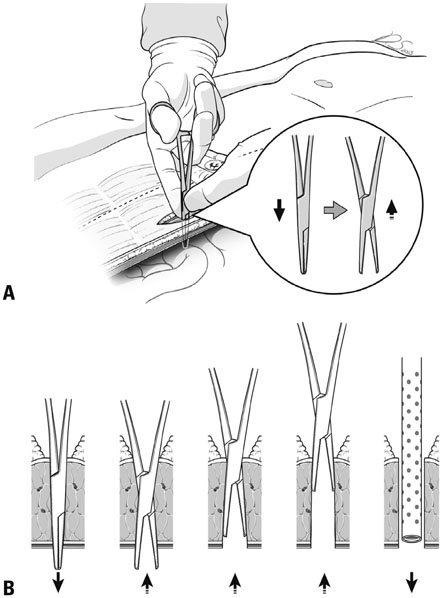Yonsei Med J.
2015 Jul;56(4):981-986. 10.3349/ymj.2015.56.4.981.
Modified Peritoneal Dialysis Catheter Insertion: Comparison with a Conventional Method
- Affiliations
-
- 1Department of Internal Medicine, NHIC, Ilsan Hospital, Goyang, Korea.
- 2Division of Nephrology, Department of Internal Medicine, Yonsei University College of Medicine, Severance Hospital, Seoul, Korea. docbsk@yuhs.ac
- KMID: 2366338
- DOI: http://doi.org/10.3349/ymj.2015.56.4.981
Abstract
- PURPOSE
The conventional trocar and cannula method in peritoneal dialysis (PD) catheter insertion has its limitation in clinical setting. The aim of this study was to compare a modified method for percutaneous PD catheter insertion with the conventional method, and demonstrate advantages of the modified method.
MATERIALS AND METHODS
Patients at a single center who had percutaneous PD catheters inserted by nephrologists from January 2006 until September 2012, using either a modified method (group M) or the conventional trocar and cannula method (group C), were retrospectively analyzed, in terms of baseline characteristics, complications experienced up to 3 months after the procedure, and the suitability of the procedure for patients.
RESULTS
Group M included 82 subjects, while group C included 66 cases. The overall early complication rate in group M (1.2%) was significantly lower than that in group C (19.7%) (p<0.001). The catheter revision rate during timeframe for early complications was significantly lower in group M (0%) than in group C (6.1%) (p=0.024). When comparing Procedure time (1 h 3 min+/-16 min vs. 1 h 36 min+/-19 min, p<0.01), immediate post-procedural pain (2.43+/-1.80 vs. 3.14+/-2.07, p<0.05), and post-procedure days until ambulation (3.95+/-1.13 days vs. 6.17+/-1.34 days, p<0.01), group M was significantly lower than group C. There was no significant difference in total hospitalization period (14.71+/-7.05 days vs. 13.86+/-3.7 days).
CONCLUSION
Our modified PD catheter insertion method shows its advantages in early complication rate, early complications revision rate, and the patients' conveniences.
Keyword
MeSH Terms
Figure
Reference
-
1. Asif A, Byers P, Gadalean F, Roth D. Peritoneal dialysis underutilization: the impact of an interventional nephrology peritoneal dialysis access program. Semin Dial. 2003; 16:266–271.
Article2. Chandna SM, Farrington K. Residual renal function: considerations on its importance and preservation in dialysis patients. Semin Dial. 2004; 17:196–201.
Article3. Rottembourg J. Residual renal function and recovery of renal function in patients treated by CAPD. Kidney Int Suppl. 1993; 40:S106–S110.4. Rottembourg J, Issad B, Allouache M, Jacobs C. Recovery of renal function in patients treated by CAPD. Adv Perit Dial. 1989; 5:63–66.5. Asif A, Pflederer TA, Vieira CF, Diego J, Roth D, Agarwal A. Does catheter insertion by nephrologists improve peritoneal dialysis utilization? A multicenter analysis. Semin Dial. 2005; 18:157–160.
Article6. Hingwala J, Diamond J, Tangri N, Bueti J, Rigatto C, Sood MM, et al. Underutilization of peritoneal dialysis: the role of the nephrologist's referral pattern. Nephrol Dial Transplant. 2013; 28:732–740.
Article7. Moreiras Plaza M, Cuíña L, Goyanes GR, Sobrado JA, Gonzalez L. Mechanical complications in chronic peritoneal dialysis. Clin Nephrol. 1999; 52:124–130.8. Basile B, De Padova F, Parisi A, Montanaro A, Giordano R. Routine insertion of permanent peritoneal dialysis catheters in the nephrology ward. The sliding percutaneous technique. Minerva Urol Nefrol. 2004; 56:359–365.9. Smith SA, Morgan SH, Eastwood JB. Routine percutaneous insertion of permanent peritoneal dialysis catheters on the nephrology ward. Perit Dial Int. 1994; 14:284–286.
Article10. Zappacosta AR, Perras ST, Closkey GM. Seldinger technique for Tenckhoff catheter placement. ASAIO Trans. 1991; 37:13–15.
Article11. Ozener C, Bihorac A, Akoglu E. Technical survival of CAPD catheters: comparison between percutaneous and conventional surgical placement techniques. Nephrol Dial Transplant. 2001; 16:1893–1899.
Article12. Adamson AS. Factors influencing peritoneal catheter survival in continuous ambulatory peritoneal dialysis. Ann R Coll Surg Engl. 1991; 73:131.13. Allon M, Soucie JM, Macon EJ. Complications with permanent peritoneal dialysis catheters: experience with 154 percutaneously placed catheters. Nephron. 1988; 48:8–11.
Article14. Jo YI, Shin SK, Lee JH, Song JO, Park JH. Immediate initiation of CAPD following percutaneous catheter placement without break-in procedure. Perit Dial Int. 2007; 27:179–183.
Article15. Henderson S, Brown E, Levy J. Safety and efficacy of percutaneous insertion of peritoneal dialysis catheters under sedation and local anaesthetic. Nephrol Dial Transplant. 2009; 24:3499–3504.
Article
- Full Text Links
- Actions
-
Cited
- CITED
-
- Close
- Share
- Similar articles
-
- Comparison of the Laparoscopic and Open Peritoneal Dialysis Catheter Insertion in Children
- A new connecting technique in partial replantation of a ruptured peritoneal dialysis catheter
- Efficacy and Safety of the Modification of the Y-TEC(R) Procedure in Peritoneal Catheter Placement: Clinical Results in 65 Patients
- Comparison of Early Complications after Peritoneal Dialysis Catheter Implantation by Laparoscopic Surgery and Conventional Surgery in Children
- Laparoscopic Continuous Ambulatory Peritoneal Dialysis (CAPD) Catheter Insertion in Children: Early Experience Comparison with Open CAPD Catheter Insertion


